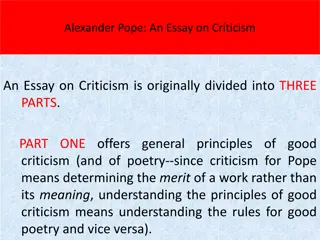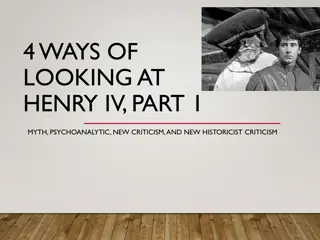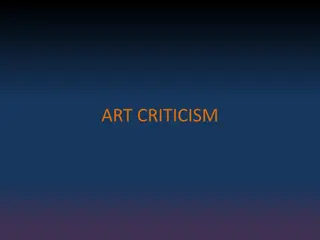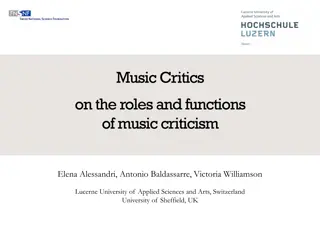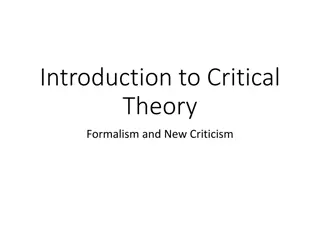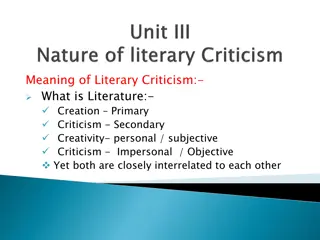Understanding Art Criticism and Aesthetic Judgement
Explore the world of art criticism and aesthetic judgement in Chapter 2 of ARTTALK. Discover the purpose of art criticism, learn to critique art, and understand aesthetic theories. Dive into the realm of professional critics, criteria for judgement, and the importance of forming your own opinions in the visual arts.
Download Presentation

Please find below an Image/Link to download the presentation.
The content on the website is provided AS IS for your information and personal use only. It may not be sold, licensed, or shared on other websites without obtaining consent from the author. Download presentation by click this link. If you encounter any issues during the download, it is possible that the publisher has removed the file from their server.
E N D
Presentation Transcript
ARTTALK Chapter 2 Art Criticism and Aesthetic Judgement
Before we start, lets watch a video that deals with Art Criticism. https://www.youtube.com/watch?v =9neybpOvjaQ
Objectives for Chapter 2: Explain the purpose of art criticism. Use the steps of art criticism. Begin to critique works of art yourself. Explain the aesthetic theories of art: Imitationalism, Formalism, and Emotionalism. Know what to look for when judging functional objects.
Art Criticism Have you ever been so involved in a movie, TV show, or video game that you felt as if you were a part of the action? Have you watched a movie so many times that you know all the lines? You were deeply involved in a work of art, weather you knew it or not. Have you talked about a TV show with your friends, what you liked and what you did not? You are critiquing it, judging it and making decisions about why it is good or bad. We do the same thing in the visual arts. There are professional critics that judge the merit of music, movies, theatre, games, and the visual arts. In this class, you will learn how to judge the visual arts yourself, rather than be told by someone else what is successful and what is not.
Art Criticism You don t always agree with a critic, because your criteria may be different from the professional critic. Criteria is the standards of judgement that a critic uses. Art criticism is an organized system for studying a work of art. Aesthetics is the philosophy or study of the nature of beauty and art. After you learn the steps of art criticism, you will be able to critique art yourself. You will learn different aesthetic theories for judging the merits of an artwork, enabling you to form your own opinions about works of art.
Art Criticism Cassatt was an Impressionist, painting outdoors to capture the effect of sunlight on her subjects. What do you see indicating this was painted outside? Where do you see the effects of sunlight? How has she used brushstrokes to give the impression of filtered light? Notice the way the woman is holding the child. What does this say about the relationship between the woman and child? Mary Cassat. Baby Reaching for an Apple. 1893. Oil on canvas. 39 x 25 .
Why Study Art Criticism? What do you think of when you hear the word criticism? Though it has a negative connotation, we use it for the positive. Just as in shopping for clothes, you use personal criteria to determine what clothing looks good on you and what does not. You have developed your own criteria through personal experience
Art Criticism When you look at this painting, are you at first confused? This would be because you do not have enough experience to develop a set of criteria to judge this work. Art criticism, when understood, makes the study of art less mysterious and more logical. Art criticism in simpler terms is an organized system for looking at and talking about art. Nancy Graves. Rheo. 1975. Acrylic, oil, and gold leaf on canvas. 64 x 64 .
Art Criticism You must think carefully about what you see. This will cause you to build your perceptual skills and learn a great deal. Use your own life experiences. No one thinks exactly like you. Just because you may see things that even the artist didn t think of does not mean you are wrong, it simply means that the work can have different meanings for different people based on their personal experiences. Learning art criticism will help you interpret works of art, and make sound aesthetic judgements, and appreciate all types of work even if you do not like it.
Your aesthetic experience is your personal interaction with a work of art. Depending on how you feel about cats, your aesthetic experience with this painting may be totally different than the person sitting next to you. The work becomes a permanent part of your memory, and then affects the way you react to other images. Th ophile-Alexandre Steinlen. Winter: Cat on a Cushion 1909.
How to Criticize a Work of Art Critiquing artwork is much like solving a mystery. You must assume the artist has a secret message hidden in the work. Your job is to find the message and solve the mystery. Art criticism is a systematic discussion of the characteristics of an artwork, usually involving four stages: description, analysis, interpretation, and judgment. 1. Description What do you see? 2. Analysis How is the work organized? 3. Interpretation What is the artist saying? 4. Judgement Is this a successful work of art?
Step One: Description In description, you make a list of all the things you see in the work. Study all the details before you make a judgement. The description should include the size of the work and the medium used. This will help you visualize the real size of the work. Notice here that that the figure here is 66 inches or 5 6 tall. How does this relate to your own height? It is cast in bronze. Do you know what bronze looks like when it is exposed to weather? In the description, list only the facts. Do not make guesses. Save that for the interpretation step. Sir Jacob Epstein. The Visitation. 1926. Bronze. 66 x 20 x 18
Step Two: Analysis In analysis, you discover how the work is organized. During this step you are still collecting facts, and paying attention to the elements of art and principles of design. Notice the shape of the figure; the lines formed by the folds in the skirt; the surface texture of her hair, skin, and fabric; and so on. Look for other elements. You will list the way the artist has used all of the elements. You will also note the way the elements of art are organized using the principles of design. Sir Jacob Epstein. The Visitation. 1926. Bronze. 66 x 20 x 18
Step Three: Interpretation In interpretation, you explain or tell the meaning or mood of the work. In this step, you try and answer, what is the artist trying to say to me? This can be the most difficult step in art criticism, because you have to think differently. You must not be afraid to make an interpretation that is different from other people. Your interpretation will depend on what you have experienced and seen in your life. Base your interpretation on the facts and clues collected in the first two steps. It is your feelings backed up by observation. Leo Twiggs. The Blue Wall. 1969. Batik painting. 24 x 30 .
Step Four: Judgement In judgement, you determine the degree of artistic merit. This is when you give your opinions based on the information gained in the previous steps. How do you feel about this picture? The artist loved cats. How do you feel about cats? How does that affect your reaction to this work? The main goal of aesthetics is to answer the question: what is successful art? Ideas or schools of thought to look for in works of art are called aesthetic theories. This can help you answer this question. Th ophile-Alexandre Steinlen. Winter: Cat on a Cushion 1909
Aesthetic Theories and Qualities of Art The aesthetic qualities most discussed by art critics are the literal qualities, the design qualities, and the expressive qualities. This is directly related to the subject, composition and content discussed earlier. 1. The literal qualities are the realistic qualities that appear in the subject of the work. 2. The design qualities are how well the work is organized. 3. The expressive qualities are the qualities that communicate ideas and moods. These three aesthetic theories are most commonly referred to as Imitationalism, Formalism, and Emotionalism.
Imitationalism and Literal Qualities Some critics think that the most important thing about a work of art is the realistic presentation of subject matter. It is their opinion that a work is successful if it looks like and reminds the viewer of what he or she sees in the real world. People with this point of view feel that an artwork should imitate life, that it should look lifelike to be considered successful. Imitationalism is the aesthetic theory that focuses on realistic presentation.
Formalism and Design Qualities Other critics think that composition is the most important factor in a work of art. Formalism is the aesthetic theory that places emphasis on the design qualities, the arrangement of the elements of art using the principles of design.
Emotionalism and Expressive Qualities This theory is concerned with the content of the work of art. Some critics claim that no object can be considered art if it fails to send a message to the viewer. The expressive quality of the art is the most important thing. Emotionalism is the aesthetic theory that requires a strong communication of feelings, moods, or ideas from the work to the viewer.
Using Aesthetic Theories Imitationalism? Formalism? Emotionalism? Margareta Haverman. A Vase of Flowers. 1716. Oil on wood. 32 x 24
Using Aesthetic Theories Imitationalism - You like that the artist has painted everything very realistically. Formalism You like the way the flowers are arranged, and how light is used to sweep from the top flower to the grapes at the bottom. Emotionalism You like flowers. Margareta Haverman. A Vase of Flowers. 1716. Oil on wood. 32 x 24
Judging Functional Objects You can use art criticism to make aesthetic judgements about functional objects as well as fine art. In criticizing functional objects, you follow the first two steps, description and analysis, as covered earlier. During interpretation, you must consider the purpose of the object as its meaning. When judging functional objects, attention must be given to function as well as aesthetic qualities. Eero Saarinen. Armchair. 1957. Molded plastic reinforced with fiberglass; painted aluminum base. 32 high.
Art Criticism /Example: Art Criticism /Example: Description 1. Look at the credit line. 2. Record the size and medium of the painting. 3. List everything you see. 4. Don t make guesses, and don t let your feelings about the work influence you. 5. Write down all every fact you observe, even the smallest details. Andrew Wyeth. Christina s World. 1948. Tempera on gesso panel. 33 x 48 .
Andrew Wyeth. Christinas World. 1948. Tempera on gesso panel. 33 x 48.
Art Criticism /Example: Art Criticism /Example: Description How much of the following did you get? What facts about the female s dress did you list? Did you notice the faded pink quality? Does the dress look new to you? Do you think the fabric is heavy or light? Look at the folds. What do they tell you about the fabric? What does the belt look like? What color is it? What matches the belt color? Notice all the individual hairs on her head? Does the way she fixes her hair match the style of her dress? Andrew Wyeth. Christina s World. 1948. Tempera on gesso panel. 33 x 48 .
Art Criticism /Example: Art Criticism /Example: Description Next, notice her shoes. What was used to make them? Are the bottom of her shoes worn? What color are her legs? Does the color quality match her arms? Do you notice anything unusual about her arms and hands? Is her left hand at the same level as the rest of her body? Where is all of her weight resting? Where is the female located? What facts can you gather by studying the ground and the rest of the background? What colors do you see? Andrew Wyeth. Christina s World. 1948. Tempera on gesso panel. 33 x 48 .
Art Criticism /Example: Art Criticism /Example: Description Notice the individual blades of grass. Are they bent in a specific direction? What is the difference between the area where she is located and the top of the hill? Did you see the road? Did you notice what kind of road it is? How many buildings do you see? How are they different? What material was used to build them? What color are they? Do you see the birds flying around one building? Andrew Wyeth. Christina s World. 1948. Tempera on gesso panel. 33 x 48 .
Art Criticism /Example: Art Criticism /Example: Description What color is the sky? From what direction is the light coming? How much of the painting is sky, and how much is ground? Was the artist looking down from above or up from below the scene? Andrew Wyeth. Christina s World. 1948. Tempera on gesso panel. 33 x 48 .
Art Criticism /Example: Art Criticism /Example: Analysis Even though we have not studied the Elements of Art and Principles of Design, notice how the work is organized. Notice how the Elements of Art are used: line, shape, form, space, color, value and texture. At this point don t worry about the Principles of Design, we will deal with those later. Andrew Wyeth. Christina s World. 1948. Tempera on gesso panel. 33 x 48 .
Art Criticism /Example: Art Criticism /Example: Interpretation Review the clues you have collected. Write down your interpretation of this work of art. Andrew Wyeth. Christina s World. 1948. Tempera on gesso panel. 33 x 48 .
Art Criticism /Example: Art Criticism /Example: Interpretation What do you think the artist is trying to say about the relationship between the female and her environment? Can you see the imaginary line leading from the left slope of the largest building to the woman s eyes? Notice how she is straining towards the house. She is wearing faded clothing, and the house looks weathered. What does that tell you about her and the house? Why do you think so much of the space in the work is taken by the ground? Andrew Wyeth. Christina s World. 1948. Tempera on gesso panel. 33 x 48 .
Art Criticism /Example: Art Criticism /Example: Interpretation Why has the artist shown separate blades of grass? Do you feel the pressure she is putting on her arms and hands? Can you feel the tension? Did you notice that her legs are not carrying any weight? Have you guessed what the artist is trying to say about the relationship between the woman and the house? Did you sense any special feelings? Other than the title, can you think of any words that describe the work? What would you title it? Andrew Wyeth. Christina s World. 1948. Tempera on gesso panel. 33 x 48 .
Art Criticism /Example: Art Criticism /Example: Interpretation Try and go beyond the events that appear to be taking place in this painting. Search for the general idea, or theme, that you think the artist is trying to express. Add the facts you discovered during the description to your personal ideas, and you will discover a meaning. Your interpretation may be different than the person next to you. Even if you collect the same facts, your different life memories will give you a different outcome. The message this work communicates is influenced by your life experience. Andrew Wyeth. Christina s World. 1948. Tempera on gesso panel. 33 x 48 .
Art Criticism /Example: Art Criticism /Example: Judgement Now you will aesthetically judge Christina s World. Imitationalism Would it be successful using this theory? Why or why not? Formalism Would this theory work? Has Wyeth done a successful job of organizing the elements of art using the principles of design? Why or why not? Emotionalism Is this the most important theory to consider this work a success? Has the work communicated a message to you? Why or why not? Andrew Wyeth. Christina s World. 1948. Tempera on gesso panel. 33 x 48 .
Art Criticism /Example: Art Criticism /Example: Judgement Not even thinking about any aesthetic theory, what do you think about this work? Does the painting make you think? Would you be able to look at it every day? Why or why not? Do you think one of the three aesthetic theories is more important in judging this work than the others? Andrew Wyeth. Christina s World. 1948. Tempera on gesso panel. 33 x 48 .
Art Criticism /Example: Art Criticism /Example: Summary (from the artist) The woman crawling through the tawny grass was the artist's neighbor in Maine, who, crippled by polio, "was limited physically but by no means spiritually." Wyeth further explained, "The challenge to me was to do justice to her extraordinary conquest of a life which most people would consider hopeless." He recorded the arid landscape, rural house, and shacks with great detail, painting minute blades of grass, individual strands of hair, and nuances of light and shadow. In this style of painting, known as magic realism, everyday scenes are imbued with poetic mystery. Andrew Wyeth. Christina s World. 1948. Tempera on gesso panel. 33 x 48 .
Practicing Art Criticism Practicing Art Criticism On a separate sheet of paper, follow the steps we have learned to do an art critique of the work shown at right. When you are done, make sure your name and class period are on it, and turn it in to me. You have the entire class. Remember to: 1. Describe 2. Analyze 3. Interpret 4. Judge Georges Seurat. A Sunday on La Grande Jatte. 1884-1886. Oil on canvas. 81 3/4 x 121 1/4 in.
Remember: 1. Description 2. Analysis 3. Interpretation 4. Judgement Georges Seurat. A Sunday on La Grande Jatte. 1884-1886. Oil on canvas. 81 3/4 x 121 1/4 in.




